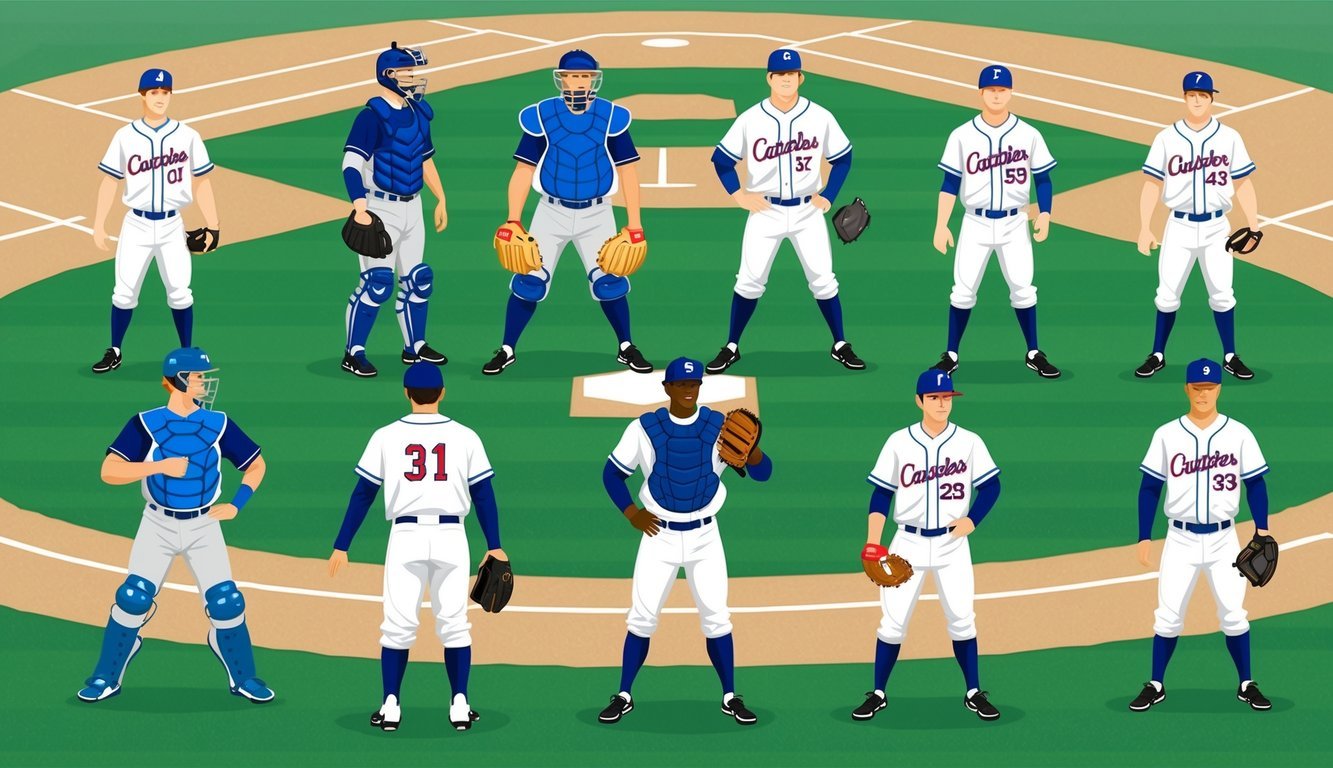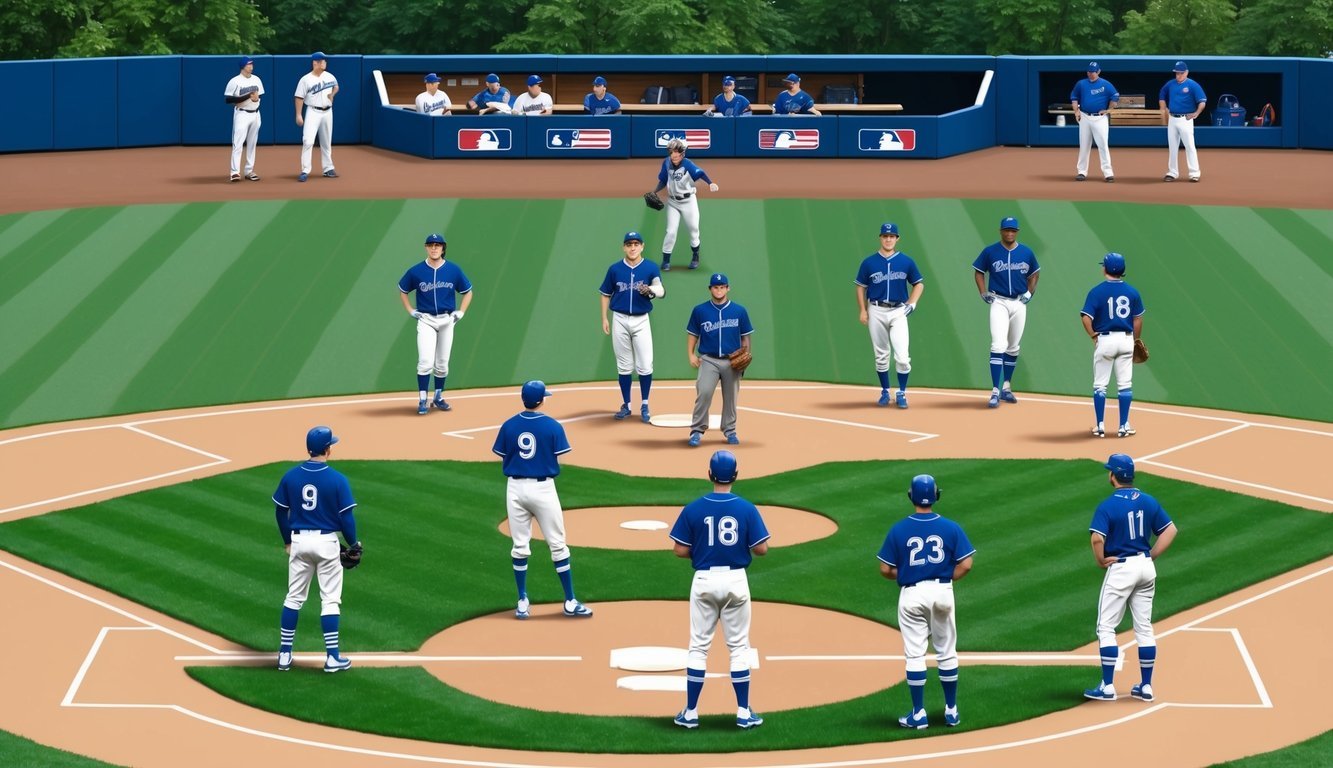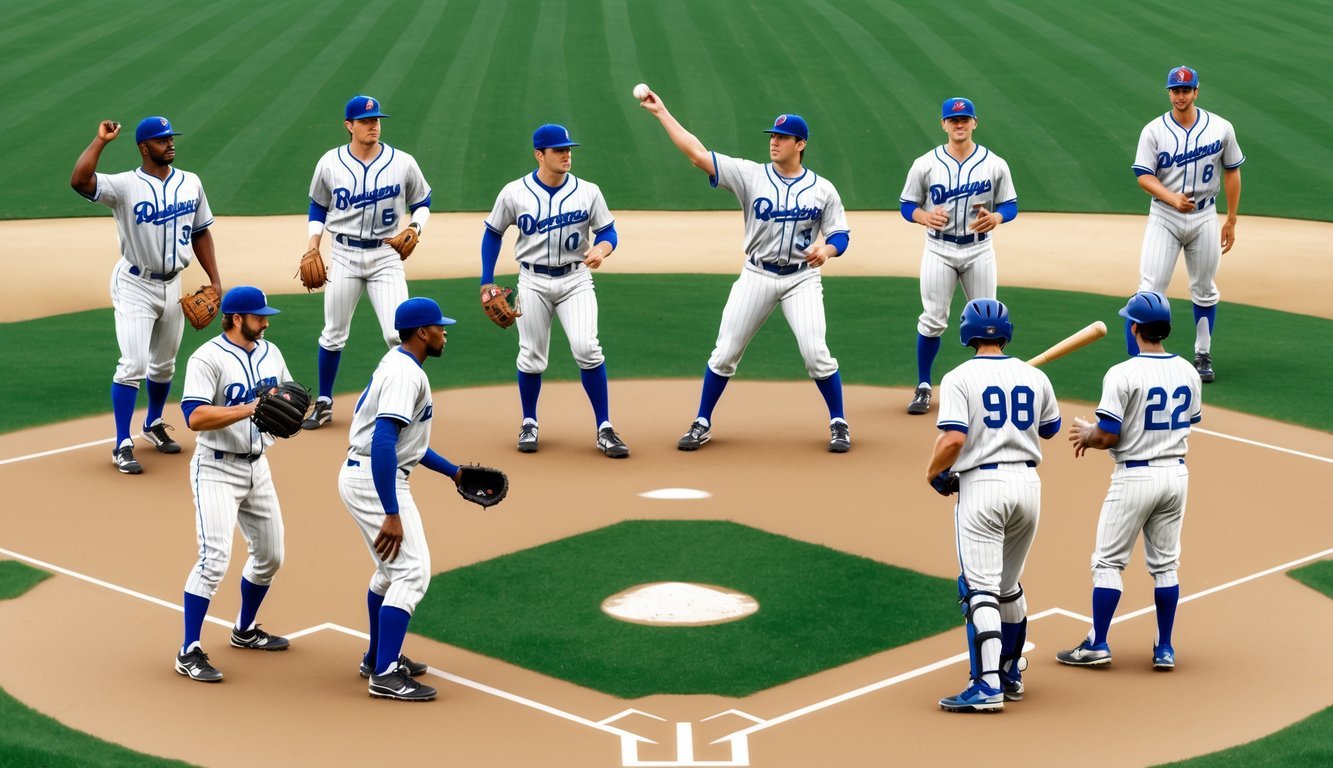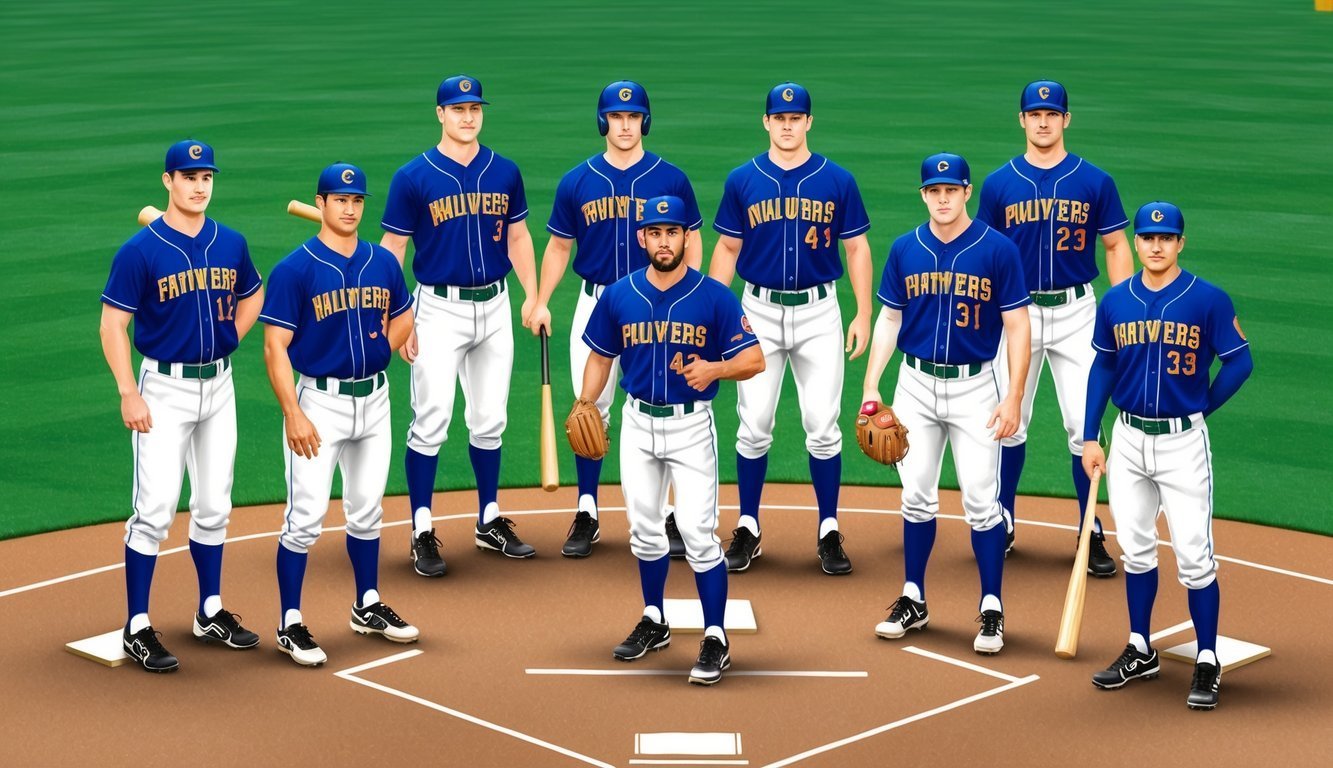Baseball teams vary in size depending on the level of play and league rules.
From Little League to the major leagues, each team has a specific number of players allowed on its roster.
In Major League Baseball (MLB), teams have 26 active players on their roster during the regular season. This number increases to 28 in September when rosters expand.
MLB teams can also have up to 40 players under major-league contracts, allowing for flexibility in managing injuries and player development.
Youth leagues often have different roster sizes to accommodate younger players and varying skill levels.
Little League teams typically have 12-15 players, ensuring everyone gets a chance to participate.
High school and college teams may have larger rosters, sometimes up to 35 players, to account for player specialization and development needs.
Understanding the Roster
Baseball teams have specific roster structures that define the number of players available for games.
These structures vary between different levels of play and can change throughout the season.
For example, Major League Baseball teams have a 26-man active roster during most of the season, with expanded rosters allowed in September.
Minor league and collegiate teams follow different roster guidelines based on league regulations.
Coaches and analysts often rely on baseball stat abbreviations to evaluate player performance and make strategic decisions.
Major League Baseball Team Structure
MLB teams have a unique roster setup.
The active roster consists of players eligible to participate in games.
This group includes a mix of position players and pitchers.
Teams carefully balance their roster to cover all positions and pitching needs.
Position players typically make up about half the active roster.
These include infielders, outfielders, and catchers.
The other half is usually pitchers, with a mix of starters and relievers.
MLB clubs also maintain a larger pool of players under contract.
This extended group forms the basis for roster moves throughout the season.
The 26-Man Roster and Its Significance
The 26-man roster is the core of an MLB team during most of the regular season.
This roster limit was implemented in 2020, replacing the previous 25-man limit.
It allows teams to carry one extra player, often an additional pitcher.
Teams can have up to 13 pitchers on the 26-man roster.
This rule helps prevent overuse of pitchers and maintains competitive balance.
The remaining spots go to position players and bench players.
During doubleheaders, teams can add a 27th player for the day.
This extra spot provides flexibility for the increased workload.
Expanding the Roster: The 40-Man Configuration
The 40-man roster is a broader group that includes the active 26-man roster plus additional players.
These extra spots are crucial for managing player development and injuries.
Players on the 40-man roster can be called up to the active roster as needed.
This flexibility allows teams to promote minor league talent or replace injured players quickly.
From September 1st until the end of the regular season, rosters expand to 28 players.
This change gives teams a chance to evaluate prospects and provide rest for regulars as the season winds down.
The 40-man roster also protects players from being selected by other teams in the Rule 5 draft.
It’s an important tool for keeping promising talent within the organization.
Types of Players and Their Roles

Baseball teams consist of specialized players who each contribute unique skills to the game.
From infielders to outfielders, pitchers to designated hitters, every position plays a crucial role in a team’s success.
Infield Positions Explained
The infield comprises four key positions: first baseman, second baseman, shortstop, and third baseman.
These players handle most ground balls and short hits.
First basemen are often tall and left-handed, making it easier to catch throws from other infielders.
They need quick reflexes and good stretching ability.
Second basemen must be agile and have a strong arm.
They cover a large area and turn double plays with the shortstop.
Shortstops are typically the most athletic infielders.
They need range, a powerful arm, and quick hands to field balls hit in the hole.
Third basemen, known as the “hot corner” players, require fast reflexes and a strong throwing arm to make long throws to first base.
The catcher, while not strictly an infielder, plays a vital role behind home plate.
They call pitches, block wild throws, and throw out base stealers.
Outfield Dynamics and Positions
Outfielders patrol the grassy area beyond the infield.
There are three outfield positions: left field, center field, and right field.
Left fielders often have less arm strength but make up for it with their batting skills.
They need to cover a lot of ground and field balls hit down the line.
Center fielders are usually the fastest outfielders.
They cover the most territory and often take charge on fly balls hit between outfielders.
Right fielders typically have the strongest arms of the outfielders.
They need to make long throws to third base and home plate.
All outfielders must be able to read the ball off the bat quickly, run efficiently to make catches, and throw accurately to cut down runners.
Understanding Pitchers and Their Impact
Pitchers are the only players who touch the ball on every play.
They come in two main types: starting pitchers and relief pitchers.
Starting pitchers begin the game and aim to pitch as many innings as possible.
They need stamina and a variety of pitches to keep batters off-balance.
Relief pitchers enter the game later, often in high-pressure situations.
They may be specialists who excel against certain types of batters.
Closers are a specific type of relief pitcher who typically pitch the ninth inning to secure a win.
They often have overpowering fastballs or deceptive breaking pitches.
Pitchers must have excellent control, mental toughness, and the ability to adapt their strategy throughout the game.
The Role of a Designated Hitter
The designated hitter (DH) is a unique position in American League baseball.
They bat in place of the pitcher but do not play in the field.
DHs are typically power hitters who can consistently produce runs.
They focus solely on hitting, allowing them to specialize in this skill.
This role often extends the careers of players who may have lost some defensive abilities but still excel at batting.
The DH adds more offensive firepower to the lineup, potentially making games higher-scoring and more exciting for fans.
Not all teams use a full-time DH, sometimes rotating the role among players to give them rest from fielding duties.
Regular Season and Postseason Player Strategies

Baseball teams carefully manage their rosters to maximize performance throughout the season and into the playoffs.
Managers must balance player usage, injuries, and strategic needs as they navigate the long regular season and intense postseason.
Managing the Active Players
Teams use a 26-man active roster during most of the regular season.
This includes a mix of starting pitchers, relievers, position players, and bench players.
Managers rotate starting pitchers to keep them fresh.
They also juggle lineup combinations based on matchups and hot streaks.
Relief pitchers often have specialized roles like closers, setup men, and long relievers.
Teams may platoon certain positions, splitting playing time between two players based on pitcher matchups.
Bench players provide defensive replacements, pinch hitters, and pinch runners.
In September, rosters expand to 28 players.
This allows teams to add depth and rest key players before the playoffs.
Strategies for the Playoffs
Playoff rosters shrink back to 26 players.
Teams adjust their roster makeup for short series.
They may carry fewer starting pitchers and more relievers.
Some starters shift to the bullpen for high-leverage situations.
Managers tighten their player rotations in the playoffs.
They lean heavily on their best players and shorten benches.
Defensive specialists see increased late-game usage.
Teams often carry a speedy pinch runner for crucial situations.
Pitching strategy changes dramatically.
Starters may pitch on short rest.
Top relievers pitch more frequently and for longer stints.
Managers match up relievers more aggressively against specific hitters.
Handling Injuries and the Injured List
The Injured List (IL) helps teams manage player health.
Players placed on the 10-day or 60-day IL don’t count against the active roster limit.
This allows teams to add replacement players.
Teams carefully time IL stints to minimize games missed.
They may use the IL for minor injuries to rest players during long stretches.
The 60-day IL frees up a 40-man roster spot for a replacement.
In the playoffs, teams can replace injured players between series.
This allows them to adjust rosters based on opponent matchups and player health.
Smart IL usage gives teams roster flexibility throughout the season and postseason.
Baseball at Different Levels

Baseball teams vary in size and structure across different levels of play.
From youth leagues to the major leagues, each level has its own unique characteristics and requirements.
High School and College Baseball Team Structures
High school baseball teams typically have 14-20 players on their rosters.
There’s no set limit, allowing flexibility based on the school’s size and talent pool.
Many schools field both varsity and junior varsity squads, each with 15-20 players.
College baseball teams operate under NCAA regulations.
Division I programs can offer up to 11.7 scholarships, often spread across 27 or more players.
Division II and III have different scholarship rules and roster sizes.
Key positions include:
- Pitchers (6-8)
- Catchers (2-3)
- Infielders (6-8)
- Outfielders (4-6)
Teams may also have designated hitters and utility players who can fill multiple roles.
Minor League Systems and their Function
Minor League Baseball serves as a developmental system for Major League Baseball (MLB) teams.
Each MLB franchise has multiple affiliated minor league teams at different levels:
- Triple-A
- Double-A
- High-A
- Low-A
- Rookie leagues
These teams help develop young talent and provide a pathway to the majors.
Minor league rosters typically have 25 active players, with additional players on the disabled list or restricted list.
The “farm system” allows MLB teams to nurture prospects, giving them playing time and experience before they reach the big leagues.
It’s an essential part of baseball’s talent pipeline.
Youth Baseball: From Little League to NCAA
Youth baseball encompasses a wide range of ages and skill levels.
Little League Baseball, one of the most popular youth organizations, has specific roster requirements:
- Major Division (ages 10-12): 12-15 players
- Minor Division (ages 7-11): 12-15 players
- Tee Ball (ages 4-7): 6-15 players
As players progress, team sizes often grow.
Travel teams and showcase teams may have larger rosters to accommodate tournament schedules.
High school teams bridge the gap between youth and college baseball.
They often have 14-20 players, preparing athletes for potential college careers.
NCAA baseball offers the highest level of amateur play.
Division I teams can have up to 35 players, with 27 receiving athletic aid.
This larger roster size allows for specialized roles and depth at each position.
The Evolution of Team Compositions

Baseball team sizes have changed significantly since the sport’s early days.
These shifts reflect evolving strategies, rules, and the game’s growing complexity.
How Team Sizes Have Changed Over Time
In the 1880s, baseball teams had as few as 11 players.
The roster expanded to 14 players a few years later.
In 1884, the National League set the limit at 25 players to prevent players from joining rival leagues.
By 1892, teams started seasons with 15 players, but this number was reduced to 13 mid-season.
The standard 25-man roster became the norm in the modern era.
Recent changes have further altered team compositions.
In 2020, Major League Baseball (MLB) expanded active rosters to 26 players.
This change allowed teams to carry an extra pitcher or position player.
The Impact of Regulations on Player Count
MLB regulations have significantly influenced team sizes.
The introduction of the 26-man roster in 2020 gave teams more flexibility in their lineups and pitching rotations.
During the COVID-19 pandemic, MLB temporarily allowed 28-player rosters to help teams manage potential outbreaks and player fatigue.
The creation of the two-way player designation has also affected team composition.
This rule allows certain players to pitch and play other positions without counting against the pitcher limit.
These changes have led to more specialized roles on teams.
Managers now have more options for late-game substitutions and pitching changes, enhancing strategic gameplay.
